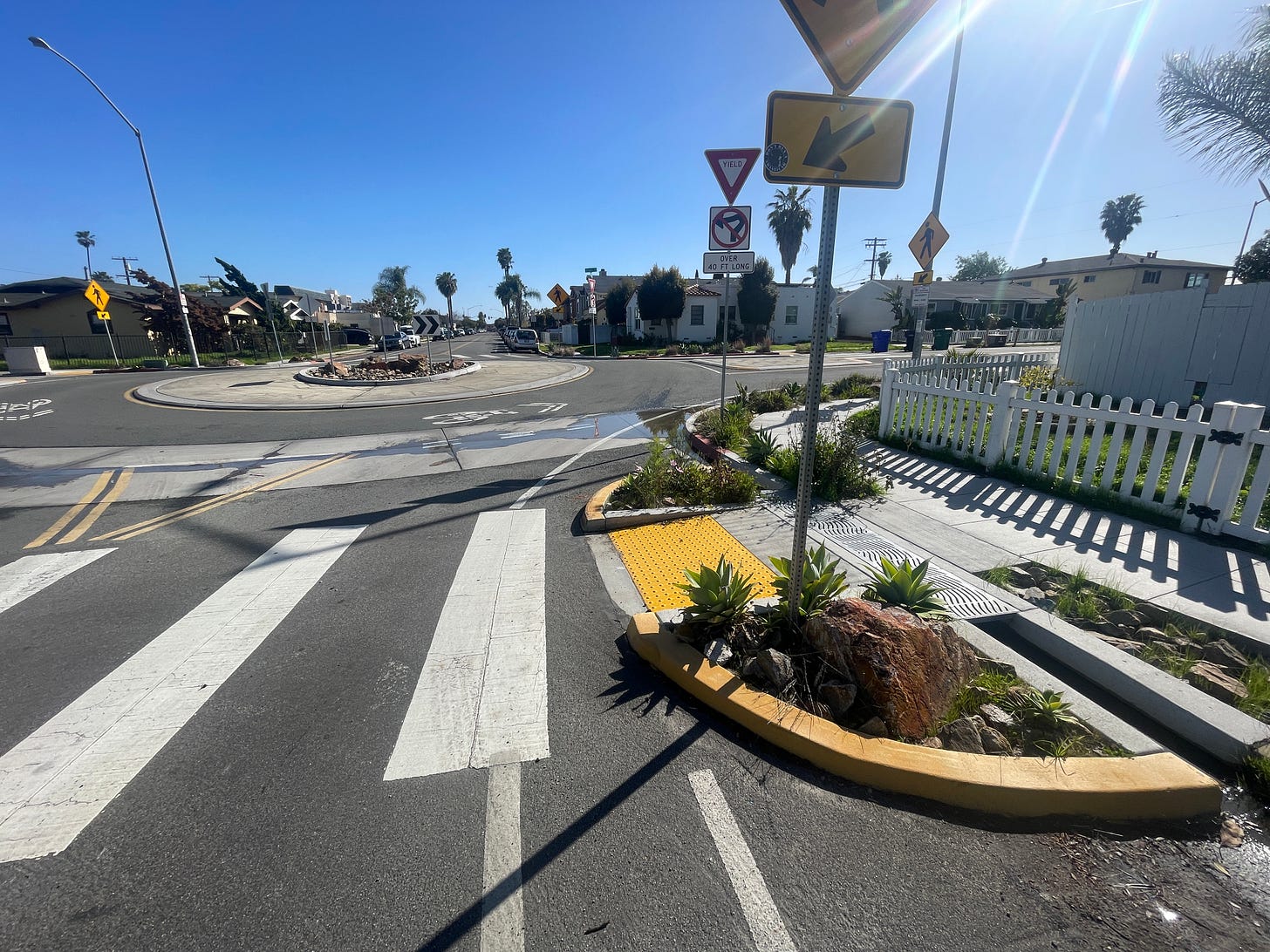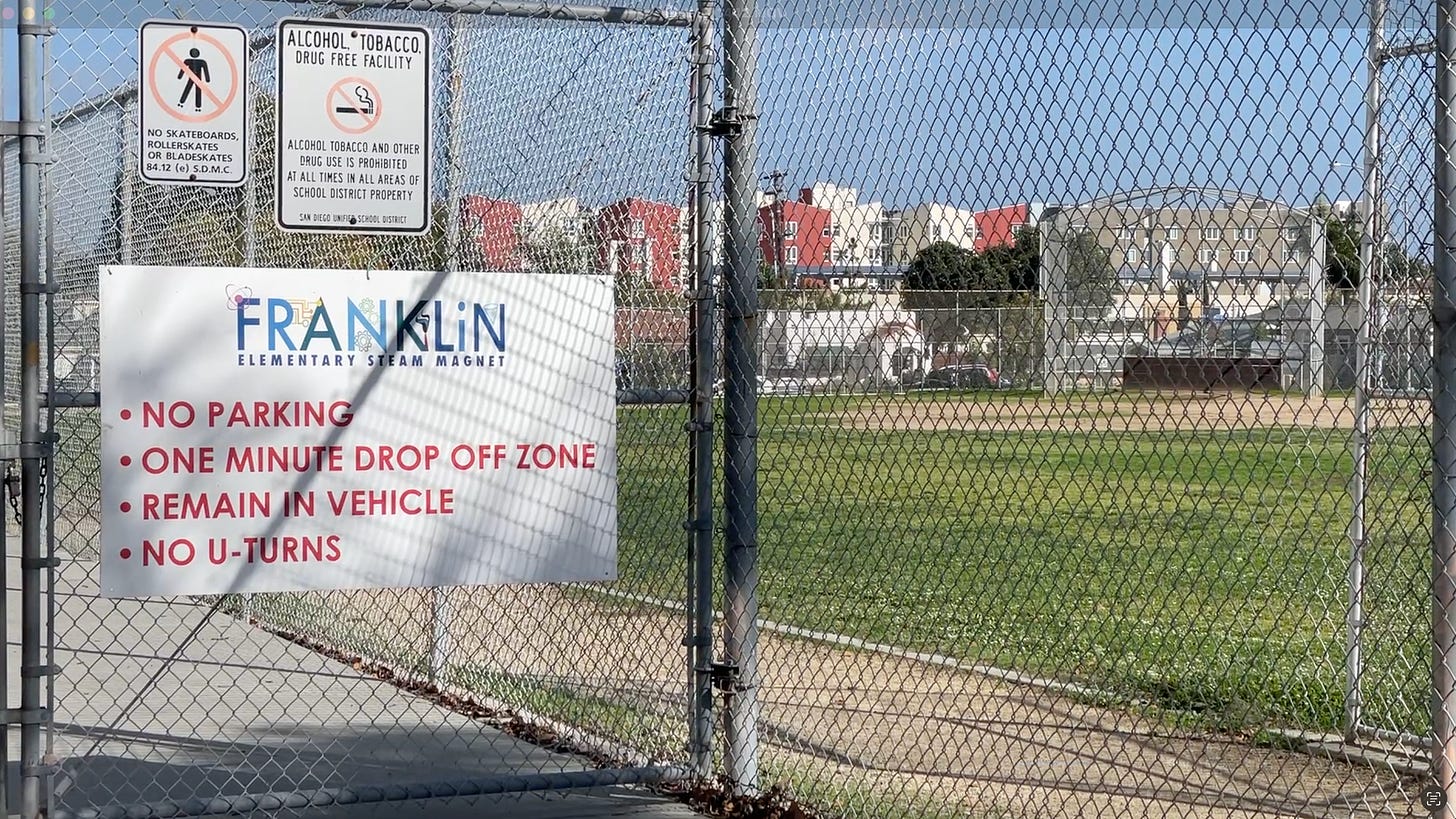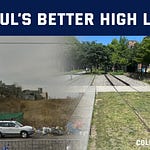Note: I have both a video essay and a write-up for this post. Please read or watch, and let me know your thoughts.
My recent article on kids no longer walking to school got a lot of attention. Many parents lauded my efforts to highlight how burdensome the car traffic pick-up line has become in the US. However, others criticized my article, saying that I was only complaining and not offering any solutions.
While I certainly mentioned some ways to improve, the article’s main focus was not on solutions to the problem. I am now making efforts to show how parents and communities can come together to make improvements to their streets so that it is safer and more reasonable for kids to walk or bike to school.
Obviously, each location is highly contextual. So what works in a dense city may not be what is needed in a rural community. Nonetheless, I hope these can highlight real efforts and possible solutions that people can consider for their own places and spaces.
The school I am focusing on today is Franklin Elementary STEAM Magnet School, located in the Kensington neighborhood of San Diego, California. So keep in mind that this example comes from a more urban space (although it is fairly suburban, too). The school itself is tucked right in the middle of a neighborhood, which obviously helps with walkability for students.
Raised Crosswalk Intersection
I hadn’t gone to San Diego with the intention of doing a post on this school. I was actually just driving by on my way back from another location shoot when I drove past this raised sidewalk. I immediately decided to investigate.
I do not see raised crosswalks all that much in the US, and definitely not in Southern California, where I live. They are incredibly useful for pedestrian infrastructure.
In normal crosswalks, the message to walkers is that they are entering a space for cars when crossing the street. Raised crosswalks do the opposite; they tell drivers they are entering a pedestrian space. This change in psychology promotes more caution and slower driving.
This area didn’t just have the raised sidewalk, the intersection also had curb bump outs with traffic calming features. They look nice, too! There is a little boulder in the middle with a variety of local plants and vegetation.
These kinds of traffic calming measures slim down the intersection lane, meaning it’s no longer designed like a motor speedway. It is a bit more difficult to navigate, forcing drivers to pay attention or else risk damaging their cars.
Now, some drivers still won’t pay attention or will continue to drive impatiently. I saw at least one blow through the stop sign when I was filming. But with the added boulder and curb extension, more of the risks will be placed onto their own vehicle rather than fully off-loaded to people walking.
Parents Fight for Safer Walks to School
Because the school is tucked right into the neighborhood, it’s obviously an easier space to navigate while walking. It did not even have a large parking lot typical of more modern-built schools. When I was there on a Saturday, there were a lot of people walking their dogs, pushing kids in strollers, and playing baseball in a field in front of the school.
But this neighborhood is not some large urban city with skyscrapers. Instead, it was mostly single-family homes, with a few two- or three-story multi-unit apartments or condos. Thus, there is still a lot of car traffic.

Sadly, the area has seen two deaths in recent years that shocked the town. One pedestrian died when a driver hit him in a crosswalk not too far from the school. In another incident, a child died in a car crash in the same area.
These incidents and other close calls prompted parents of Franklin students to demand safer streets. They organized a petition demanding that the city install a stop sign at the back entrance of the school. “Our students on safety patrol get cursed by angry drivers trying to reach the 805 and the issue has gotten so bad that the adult supervising keeps a tally of near misses,” stated the petition.
Happily, the demands worked, and the city has agreed to install stop signs. To be clear, these stop signs are different from the raised crosswalk that is at the front of the school. But the movement shows there are local grassroots efforts to make the area more walkable and kid-friendly.
Citywide Bikeway
The raised sidewalk at the front of the school is part of the Georgia–Meade Bikeway. Completed in 2022, the bikeway runs 3.5 miles through the city, connecting to several other bikeways totaling roughly 13 miles.
It features bend-outs, buffered bike lanes, chokers, traffic circles, and raised sidewalks, which were featured above in front of the Franklin School. I should mention that the bike lines still aren’t protected in the sections I saw, only included painted buffers. The lack of real barriers is certainly a limitation—bad choice.

I was particularly taken by the traffic circles, with one located two blocks from the school. These help slow down cars while also allowing smooth traffic flow. Like the raised sidewalk intersection, the traffic circle had boulders in the middle with curb planters on the edge.
I even saw little birds using the flora for shade. It certainly makes the space look nice while also offering protection from cars. Indeed, the boulders and curb extensions will cause inattentive drivers to wreck their own cars rather than a child walking to school.
In fact, the YouTube Channel Riding Bikes in San Diego caught one such person on another sidewalk down the street. The driver plowed right into the boulder, their car wrecked, but no one outside of the car was hurt. This is an ideal way of dealing with such incidents.
Since San Diego has perfect weather year-round, this kind of infrastructure is a no-brainer. It should be massively expanded, with added protected bike lanes and broader networks. I still saw signs pleading with drivers to slow down. The key is to have separate, well-intentioned infrastructure for bikes and pedestrians that has physical barriers protecting them from speeding cars.
One Thing at a Time
I am not going to sit here and tell you that building one raised sidewalk and traffic circle is suddenly going to rocket the local community’s walk-to-school rate from 5% to 50%. Rapid change like this is not very likely in most places. Even in this exact area, there are still issues with cars driving too fast.
The point is that there are small things that parents can do to make their places better for their children. Little things can add up over time. Eventually, more and more people will be out walking rather than driving. Incremental change requires a lot of time and effort.
In the end, the key is slowing down cars and giving the choice to parents, kids, and the broader community on walking, biking, or driving. Right now, most places simply have one option because the totality of the car-built environment has been chosen for them.











